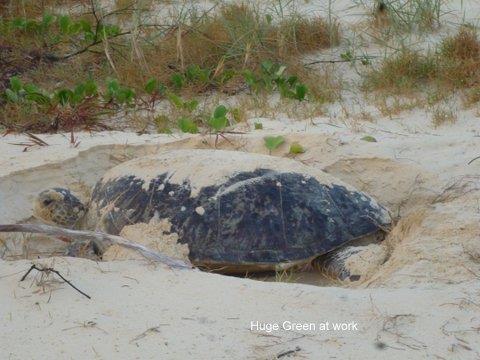Overview:
Green marine turtles are listed as Vulnerable but have been gradually increasing in numbers at about 3% a year in the Southern Great Barrier Reef through to Southern Queensland since the early 1950’s when all marine turtles became protected species in Queensland.
Loggerheads are listed as Endangered and were heavily impacted by the trawl fishery before the introduction of TEDs (Turtle Exclusion Devices) in the 1990s. While the mainland rookeries have recovered to about 80% of their 1960s numbers, the Great Barrier Reef island rookeries have only recovered to about 20%. Sandy Cape is a part of the Bundaberg Coast-mainland population, with the occasional turtle nesting at both rookeries, and the population synchronizing at about 11% of Mon Repos for most of the 17 years from 1994 when an annual census was conducted for the last two weeks of each December.
An estimated 44 loggerheads currently nest at Sandy Cape each year.

Green turtle numbers vary dramatically from season to season, and we hope to be able to estimate this season’s population from three short 6/7/6-day track count surveys taken in late November, late December, and early February.
Monitoring/Nest relocation & Predation Survey time frame:
The loggerhead turtle nest relocation project is carried out annually from 20 November to 20 February.
This season there was a nest predation survey conducted on green turtle nests, with a snapshot for seven days from 22 December, and six days from 7 February, following on from a similar survey for the December 2018 period last season.

Sadly, not all spaces in the roster were filled due to health and other issues, which resulted in many loggerhead nests lost to predation by dingoes over 4 of the busiest nine weeks of the season which are between 1 December and 31 January.
Nest Relocation:
Thirty-four loggerhead nests were relocated to the secure aluminium mesh relocation cages. Even during the relocation patrols, numerous loggerhead nests were totally or partially predated by dingoes before the Volunteer Caretakers reached them.
Predation Survey:
Sixty-one green nests were staked on the beach with pegs in December and monitored each week. As of the 24/03/2020, 60 of the staked nests were totally or partially predated.
This makes a compelling case for the necessity to intervene and relocate nests of the endangered loggerhead.

During monitoring, 44 greens have been tagged with titanium flipper tags. Those turtles that already had one tag had another tag inserted. All other turtles had two tags inserted. This assists in gathering /adding more data. Green turtle nests are not relocated, nor are they monitored for hatchling/shell count and success rate (as are the loggerhead clutches relocated to the cages.)
Beach Conditions:
At times beach conditions for driving were excellent (like an airstrip all the way). However, with 2m tides and strong northerlies causing severe erosion, the situation on the beach could change overnight, to gutters and melon holes. A considerable amount of pumice stone was washed up onto the beaches in early February making discovery and identification of turtle tracks in some places more difficult.
At one stage, Browns Rocks’ cage was inaccessible because of a 3m bank, so nests were relocated to Carrie cage. Carrie cage may need to be moved next season because of tree roots. Tree/grass roots absorb the moisture in the sand, which is detrimental to the development of the hatchling.
Tide times govern when patrols are carried out – either day or night. The monitoring was delayed a day, on 7 February, as 243mm of rain washed out all turtle tracks on the beach.
Satellite tracking:

This season no satellite trackers were attached to Sandy Cape turtles. The tracking of 26 male and female green and loggerhead turtles conducted in previous years at Sandy Cape provided data to support, or propose extensions, to Great Sandy Marine Park zoning (to protect the turtles with Go-Slow and Green Zones during their courting and inter-nesting times). Courting takes place from the end of September to early December, and they nest from early October to late March coming ashore between 3 and 8 times a season each, with about a 15-day inter-nesting period in-between.
Satellite trackers also provide a broader picture of the turtle’s life cycle – the inter-nesting and courting habitat, and then at the end of the season the migratory pathways, and home range foraging habitats, which are between a hundred kilometres to three thousand kilometres away.
Over the last two nesting seasons, trackers were attached to two female loggerhead turtles nesting in Hervey Bay to provide data on inter-nesting habits of loggerheads on the Wide Bay coast.
Thank you to the Volunteer Caretakers for providing the data from the Sandy Cape Nest Relocation and Predation Survey Program.
Report submitted by Lesley Bradley & Aub Strydom